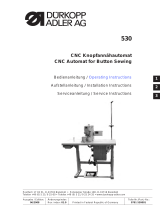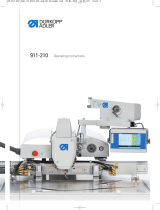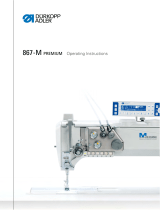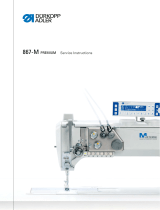
Table of Contents
2 Operating Instructions 512/532 - 05.0 - 04/2018
4.10 Sewing.................................................................................................36
4.11 Counter................................................................................................36
4.12 Pausing sewing...................................................................................37
4.13 Disabling standard seam appearances...............................................37
4.14 Saving seam appearances..................................................................38
4.14.1 Assigning the memory buttons............................................................38
4.14.2 Sewing with the memory buttons ........................................................39
4.14.3 Deleting the memory button assignments...........................................39
4.15 Saving seam appearance sequences .................................................40
4.16 Sewing with a seam appearance sequence........................................41
4.17 Deleting a seam appearance sequence..............................................41
4.18 Finishing sewing..................................................................................42
4.19 Editing parameters in memory ............................................................42
4.19.1 Editing parameters at the M1 level......................................................42
4.19.2 Editing parameters at the M2 level......................................................43
4.20 Resetting parameters to factory defaults.............................................44
4.21 Externally editing seam appearances .................................................45
4.22 Working with a USB stick ....................................................................47
4.23 Loading software from a USB stick.....................................................50
4.23.1 Loading the main program ..................................................................50
4.23.2 Loading seam appearances................................................................51
4.23.3 Setting parameter U085 (Class 532)...................................................51
4.23.4 Checking the software version ............................................................52
4.24 Seam appearances .............................................................................53
4.24.1 Standard seam appearances for class 512.........................................53
4.24.2 Standard seam images for class 532..................................................57
5 Maintenance.......................................................................................59
5.1 Cleaning ..............................................................................................60
5.2 Lubricating...........................................................................................62
5.2.1 Checking the oil level ..........................................................................63
5.2.2 Lubricating with grease .......................................................................65
6 Setup ..................................................................................................69
6.1 Checking the scope of delivery ...........................................................69
6.2 Removing the transport securing devices ...........................................70
6.3 Assembly.............................................................................................70
6.3.1 Checking the table plate......................................................................70
6.3.2 Assembling the frame..........................................................................71
6.3.3 Completing the table plate...................................................................72
6.3.4 Mounting the upper section support....................................................74
6.3.5 Setting the working height...................................................................75
6.3.6 Mounting upper machine section ........................................................76
6.3.7 Fitting the oil collection reservoir.........................................................77
6.3.8 Electrical connection ...........................................................................78

































